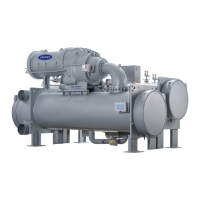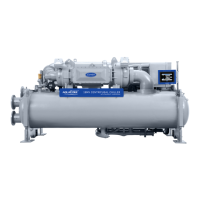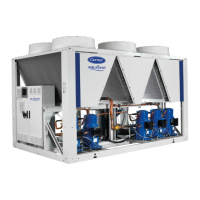2
Manual Guide Vane Operation . . . . . . . . . . . . . . . . . 39
Refrigeration Log . . . . . . . . . . . . . . . . . . . . . . . . . . . . 39
PUMPOUT AND REFRIGERANT
TRANSFER PROCEDURES . . . . . . . . . . . . . . . . . 39
Preparation . . . . . . . . . . . . . . . . . . . . . . . . . . . . . . . . . 39
Operating the Optional Pumpout Unit (Fig. 37) . . . 41
GENERAL MAINTENANCE . . . . . . . . . . . . . . . . . . . . 44
R
efrigerant Properties . . . . . . . . . . . . . . . . . . . . . . . . 44
Adding Refrigerant . . . . . . . . . . . . . . . . . . . . . . . . . . 44
Adjusting the Refrigerant Charge . . . . . . . . . . . . . . 44
Refrigerant Leak Testing . . . . . . . . . . . . . . . . . . . . . 44
Leak Rate . . . . . . . . . . . . . . . . . . . . . . . . . . . . . . . . . . 44
Test After Service, Repair, or Major Leak . . . . . . . . 44
Repair the Leak, Retest, and Apply
Standing Vacuum Test . . . . . . . . . . . . . . . . . . . . . 44
Checking Guide Vanes . . . . . . . . . . . . . . . . . . . . . . . 44
Trim Refrigerant Charge . . . . . . . . . . . . . . . . . . . . . . 44
WEEKLY MAINTENANCE
. . . . . . . . . . . . . . . . . . . . . 47
Check the Lubrication System . . . . . . . . . . . . . . . . . 47
SCHEDULED MAINTENANCE . . . . . . . . . . . . . . . . . .
47
Service Ontime . . . . . . . . . . . . . . . . . . . . . . . . . . . . . 47
Inspect the Control Panel . . . . . . . . . . . . . . . . . . . . . 47
Changing Oil Filter . . . . . . . . . . . . . . . . . . . . . . . . . . 47
Oil Specification . . . . . . . . . . . . . . . . . . . . . . . . . . . . 47
Oil Changes . . . . . . . . . . . . . . . . . . . . . . . . . . . . . . . . 47
Refrigerant Filter . . . . . . . . . . . . . . . . . . . . . . . . . . . . 47
VFD Refrigerant Strainer (if equipped) . . . . . . . . . . 48
Oil Reclaim Filter . . . . . . . . . . . . . . . . . . . . . . . . . . . . 48
Inspect Refrigerant Float System . . . . . . . . . . . . . . 48
Inspect Relief Valves and Piping . . . . . . . . . . . . . . . 49
Compressor Bearing and Gear Maintenance . . . . . 49
Inspect the Heat Exchanger Tubes and
Flow Devices . . . . . . . . . . . . . . . . . . . . . . . . . . . . . 49
Water Leaks . . . . . . . . . . . . . . . . . . . . . . . . . . . . . . . . 49
Water Treatment . . . . . . . . . . . . . . . . . . . . . . . . . . . . 49
Inspect the Starting Equipment or VFD . . . . . . . . . . 50
Recalibrate Pressure Transducers . . . . . . . . . . . . . 50
Optional Pumpout System Maintenance . . . . . . . . . 50
Ordering Replacement Chiller Parts . . . . . . . . . . . . 50
TRO
UBLESHOOTING GUIDE . . . . . . . . . . . . . . . . . . 51
Overview . . . . . . . . . . . . . . . . . . . . . . . . . . . . . . . . . . . 51
Checking Display Messages . . . . . . . . . . . . . . . . . . 51
Checking Temperature Sensors . . . . . . . . . . . . . . . 51
Checking Pressure Transducers . . . . . . . . . . . . . . . 55
High Altitude Locations . . . . . . . . . . . . . . . . . . . . . . 55
Quick Test . . . . . . . . . . . . . . . . . . . . . . . . . . . . . . . . . 55
Pumpdown/Lockout . . . . . . . . . . . . . . . . . . . . . . . . . 55
Physical Data . . . . . . . . . . . . . . . . . . . . . . . . . . . . . . . 55
APPENDIX A
— PIC 6 SCREEN AND TABLE
STRUCTURE . . . . . . . . . . . . . . . . . . . . . . . . . . . . 109
APPENDIX B
— CCN COMMUNICATION WIRING
FOR MULTIPLE CHILLERS (TYPICAL) . . . . . . . 111
APPENDIX C — MAINTENANCE SUMMARY
AND LOG SHEETS . . . . . . . . . . . . . . . . . . . . . . . 112
INDEX . . . . . . . . . . . . . . . . . . . . . . . . . . . . . . . . . . . . 115
INITIAL START-UP CHECKLIST
FOR 19XR SEMI-HERMETIC TWO-STAGE
CENTRIFUGAL LIQUID CHILLER . . . . . . . . . . . CL-1
SAFETY CONSIDERATIONS
Centrifugal liquid chillers are designed to provide safe and reli-
able service when operated within design specifications. When
operating this equipment, use good judgment and safety pre-
cautions to avoid damage to equipment and property or injury
to personnel.
Be sure you understand and follow the procedures and safety
precautions contained in the chiller instructions as well as
those listed in this guide.
DANGER
Failure to follow these procedures will result in severe per-
sonal injury or death.
DO NOT VENT refrigerant relief valves within a building.
Outlet from rupture disc or relief valve must be vented out-
doors in accordance with the latest edition of ANSI/
ASHRAE 15 (American National Standards Institute/
American Society of Heating, Refrigerating, and Air-
Conditioning Engineers). The accumulation of refrigerant
in an enclosed space can displace oxygen and cause
asphyxiation.
PROVIDE adequate ventilation in accordance with ANSI/
ASHRAE 15, especially for enclosed and low overhead
spaces. Inhalation of high concentrations of vapor is harm-
ful and may cause heart irregularities, unconsciousness, or
death. Misuse can be fatal. Vapor is heavier than air and re-
duces the amount of oxygen available for breathing. Prod-
uct causes eye and skin irritation. Decomposition products
are hazardous.
DO NOT USE OXYGEN to purge lines or to pressurize a
chiller for any purpose. Oxygen gas reacts violently with
oil, grease, and other common substances.
NEVER EXCEED specified test pressures; VERIFY the al-
lowable test pressure by checking the instruction literature
and the design pressures on the equipment nameplate.
DO NOT USE air for leak testing. Use only refrigerant or
dry nitrogen.
DO NOT VALVE OFF any safety device.
BE SURE that all pressure relief devices are properly in-
stalled and functioning before operating any chiller.
RISK OF INJURY OR DEATH by electrocution. High
voltage is present on motor leads even though the motor is
not running when a solid-state or wye-delta mechanical
starter is used. Open the power supply disconnect before
touching motor leads or terminals.

